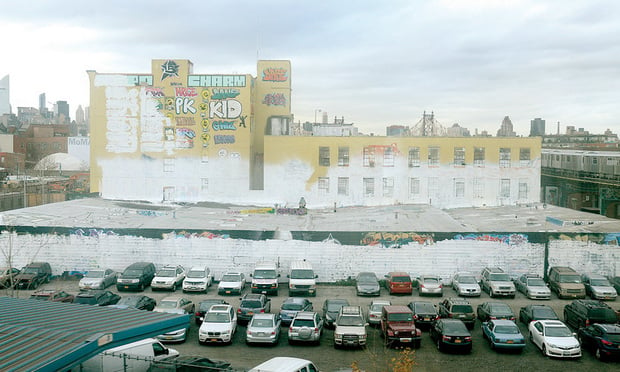5Pointz Artists Awarded $6.75M in Damages
If a building owner finds itself in a position where it must remove art protected by VARA and no written VARA waiver was obtained, the owner should proceed cautiously and in good faith in the destruction or removal of the art.
March 28, 2018 at 02:30 PM
7 minute read

In the latest development in the ongoing saga of the 5Pointz litigation, the U.S. District Court of the Eastern District of New York recently awarded plaintiffs, a group of graffiti artists, a total judgment of $6,750,000.00 under the Visual Artists Rights Act of 1990 (VARA) against real estate developer and property owner, Gerald Wolkoff for his white-washing and eventual demolition of the street art painted on the exterior walls of his buildings located in Long Island City, Queens.
VARA protects visual artists against the intentional destruction, mutilation, or other modification of visual art of “recognized stature.” 17 U.S.C. § 106A(a)(3). The buildings, known as “5Pointz,” were, at one point, abandoned and vandalized in the 1990s until plaintiff Jonathan Cohen, with Wolkoff's permission, began curating the space by carefully selecting the artists and artwork permitted to be shown there. The works were always intended to be temporary. Indeed, the artists understood that the walls served as a rotating platform for other artists, that the majority of the works would be painted-over regularly to make room for others, and that eventually, the buildings themselves would be torn down. See Jonathan Cohen v. G&M Realty L.P., No. 13-CV-05612 (FB)(RLM); No. 15-CV-3230(FB)(RLM), 2018 U.S. Dist. LEXIS 22662, at *18 (E.D.N.Y. Feb. 18, 2018).
Though the court denied plaintiffs' request in 2013 for a preliminary injunction to prevent the destruction of their art, the court held that street art fell under the purview and protections of VARA despite their “subculture” status and despite their temporary nature. See generally Jonathan Cohen v. G&M Realty L.P., 988 F. Supp. 2d 212 (E.D.N.Y. 2013). The court reasoned in 2013 that VARA protects visual art of all mediums and that the artists' acknowledgment of the venue's temporary nature would not serve to waive the artists' VARA rights and protections; indeed, only a written instrument executed by the artist could effect such waiver. Id. What was left to be decided at trial was simply whether and which of the 49 artworks in question would meet the criteria of “recognized stature” necessary to invoke VARA protections. Id.
After a full trial on the merits lasting three weeks, the court issued an opinion on Feb. 12, 2018 that not only found for plaintiffs, but also awarded damages of $6.75 million, the maximum statutory amount permitted. The court recited that the whitewashing was done sloppily shortly after the injunction was denied with no notice to the artists to permit removal and the buildings were not demolished for months after the whitewashing, leaving the damaged art “visible by millions of people on the passing 7 train.” Cohen, 2018 U.S. Dist. LEXIS 22662, at *20. This article will address the key takeaways and significance of the court's opinion.
Recognized Stature
The court's opinion shed further light on the factors and considerations for determining “recognized stature.”
The court summarized that Carter v. Helmsley-Spear, remained the seminal case in defining the phrase “recognized stature”—not defined in VARA—which requires “a two-tiered showing: (1) that the visual art in question has 'stature,' i.e., is viewed as meritorious, and (2) that this stature is 'recognized' by art experts, other members of the artistic community, or by some cross-section of society.” Cohen, 2018 U.S. Dist. LEXIS 22662, at *27 (citing 861 F. Supp. 303-25 (S.D.N.Y. 1994)).
As the 5Pointz court noted in its 2013 opinion, the question would be whether the court would, in defining recognized stature, “embrace the strictures of the academic views espoused by the defendants or the more expansive ones suggested by the plaintiffs.” Cohen, 988 F. Supp. at 226.
After surveying the current state of the law, the court found the “plaintiffs adduced such a plethora of exhibits and credible testimony, including the testimony of a highly regarded expert, that even under the most restrictive of evidentiary standards almost all of the plaintiffs' works easily qualify as works of recognized stature.” Cohen, 2018 U.S. Dist. LEXIS 22662, at *30. Nonetheless, it was telling that the court pointed to the lack of “significant third-party attention or social media buzz” and “social media coverage” as the sole basis for dismissing certain works as lacking “recognized stature,” signaling a move away from the higher standard of academic, scholarly expert consensus towards a more populace-based determination. Id. at 34. Indeed, the court criticized the defendant's witness for using an “unduly restrictive interpretation of recognized stature that was more akin to a masterpiece standard.” Id. at 32. It remains to be seen how and whether courts will adopt this court's interpretation of “recognized stature,” and how much weight “third party attention” and “social media buzz” will bear on such analysis in the future.
Statutory Damages and Willfulness
The court's opinion also provided further guidance on the determination of damages. While VARA does not impose a limit on the amount of actual damages for each work, a plaintiff is not entitled to both actual and statutory damages but must elect one or the other. 17 U.S.C. §504(c)(1). Statutory damages may be between $750 and $30,000 “as the court considers just,” but if the court finds that infringement was committed willfully, the court may increase the award for each work to up to $150,000. 17 U.S.C. §504(c)(1) & (2). Statutory damages may also be particularly appropriate “when no actual damages are proven or they are difficult to calculate.” Cohen, 2018 U.S. Dist. LEXIS 22662, at *39 (citing Warner Bros. v. Dae Rim Trading, 877 F.2d 1120, 1126 (2d Cir. 1989)).
Here, the court found that actual damages were impossible to ascertain since there was no reliable market value for the work. As a result, the court moved to award statutory damages, which was determined based on the following considerations: (1) the infringer's (in this case the building owner) state of mind; (2) the expenses saved, and profits earned, by the infringer; (3) the revenue lost by the copyright holder; (4) the deterrent effect on the infringer and third parties; (5) the infringer's cooperation in providing evidence concerning the value of the infringing material; and (6) the conduct and attitude of the parties. Id. at 44-45.
The court noted that the most significant factor here was the fourth prong—the deterrent effect on the infringer and third parties. Id. at 47. Finding Wolkoff to be “willful,” “unrepentant,” “unresponsive,” a “difficult witness” and “argumentative,” the court stated that “[i]f not for Wolkoff's insolence, these damages would not have been assessed.” See generally id. at 49. The court even stated that, “[g]iven the degree of difficulty in proving actual damages, a modest amount of statutory damages would probably have been more in order.” Id. Because of Wolkoff's conduct (both inside and outside of the courtroom), however, the court awarded the maximum statutory damages permitted under VARA.
Final Remarks
If a building owner finds itself in a position where it must remove art protected by VARA and no written VARA waiver was obtained, the owner should proceed cautiously and in good faith in the destruction or removal of the art. For example, notice should be provided to the artist of the landlord's intention to remove the art, ample time should be provided for its removal (no less than 90 days), and other accommodations should be made to facilitate the art's preservation and removal. Though an action for injunction may still ensue if the work cannot be safely removed without destruction, the hope is that any damage award would, at the very least, be mitigated in light of the owner's good faith efforts. In 5Pointz, maximum statutory damages were awarded because of the landlord's aggressive actions, which were held to be an insult to the artists.
Thomas D. Kearns is a partner with Olshan Frome Wolosky's real estate department. Follow him on Twitter @TDKearns. Carolyn Sha is an associate with Mintz, Levin, Cohn, Ferris, Glovsky and Popeo, P.C. in San Francisco.
This content has been archived. It is available through our partners, LexisNexis® and Bloomberg Law.
To view this content, please continue to their sites.
Not a Lexis Subscriber?
Subscribe Now
Not a Bloomberg Law Subscriber?
Subscribe Now
NOT FOR REPRINT
© 2025 ALM Global, LLC, All Rights Reserved. Request academic re-use from www.copyright.com. All other uses, submit a request to [email protected]. For more information visit Asset & Logo Licensing.
You Might Like
View All
Skadden and Steptoe, Defending Amex GBT, Blasts Biden DOJ's Antitrust Lawsuit Over Merger Proposal
4 minute read
Come Fly With Me: DOJ’s Proposed FARA Amendments and the Tourism Industry
10 minute readTrending Stories
- 1Contract Technology Provider LegalOn Launches AI-powered Playbook Tool
- 2Court of Appeals Provides Comfort to Land Use Litigants Through the Relation Back Doctrine
- 3Amid the Tragedy of the L.A. Fires, a Lesson on the Value of Good Neighbors
- 4Democracy in Focus: New York State Court of Appeals Year in Review
- 5In Vape Case, A Debate Over Forum Shopping
Who Got The Work
J. Brugh Lower of Gibbons has entered an appearance for industrial equipment supplier Devco Corporation in a pending trademark infringement lawsuit. The suit, accusing the defendant of selling knock-off Graco products, was filed Dec. 18 in New Jersey District Court by Rivkin Radler on behalf of Graco Inc. and Graco Minnesota. The case, assigned to U.S. District Judge Zahid N. Quraishi, is 3:24-cv-11294, Graco Inc. et al v. Devco Corporation.
Who Got The Work
Rebecca Maller-Stein and Kent A. Yalowitz of Arnold & Porter Kaye Scholer have entered their appearances for Hanaco Venture Capital and its executives, Lior Prosor and David Frankel, in a pending securities lawsuit. The action, filed on Dec. 24 in New York Southern District Court by Zell, Aron & Co. on behalf of Goldeneye Advisors, accuses the defendants of negligently and fraudulently managing the plaintiff's $1 million investment. The case, assigned to U.S. District Judge Vernon S. Broderick, is 1:24-cv-09918, Goldeneye Advisors, LLC v. Hanaco Venture Capital, Ltd. et al.
Who Got The Work
Attorneys from A&O Shearman has stepped in as defense counsel for Toronto-Dominion Bank and other defendants in a pending securities class action. The suit, filed Dec. 11 in New York Southern District Court by Bleichmar Fonti & Auld, accuses the defendants of concealing the bank's 'pervasive' deficiencies in regards to its compliance with the Bank Secrecy Act and the quality of its anti-money laundering controls. The case, assigned to U.S. District Judge Arun Subramanian, is 1:24-cv-09445, Gonzalez v. The Toronto-Dominion Bank et al.
Who Got The Work
Crown Castle International, a Pennsylvania company providing shared communications infrastructure, has turned to Luke D. Wolf of Gordon Rees Scully Mansukhani to fend off a pending breach-of-contract lawsuit. The court action, filed Nov. 25 in Michigan Eastern District Court by Hooper Hathaway PC on behalf of The Town Residences LLC, accuses Crown Castle of failing to transfer approximately $30,000 in utility payments from T-Mobile in breach of a roof-top lease and assignment agreement. The case, assigned to U.S. District Judge Susan K. Declercq, is 2:24-cv-13131, The Town Residences LLC v. T-Mobile US, Inc. et al.
Who Got The Work
Wilfred P. Coronato and Daniel M. Schwartz of McCarter & English have stepped in as defense counsel to Electrolux Home Products Inc. in a pending product liability lawsuit. The court action, filed Nov. 26 in New York Eastern District Court by Poulos Lopiccolo PC and Nagel Rice LLP on behalf of David Stern, alleges that the defendant's refrigerators’ drawers and shelving repeatedly break and fall apart within months after purchase. The case, assigned to U.S. District Judge Joan M. Azrack, is 2:24-cv-08204, Stern v. Electrolux Home Products, Inc.
Featured Firms
Law Offices of Gary Martin Hays & Associates, P.C.
(470) 294-1674
Law Offices of Mark E. Salomone
(857) 444-6468
Smith & Hassler
(713) 739-1250







